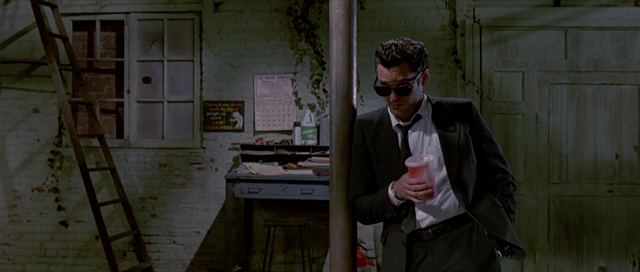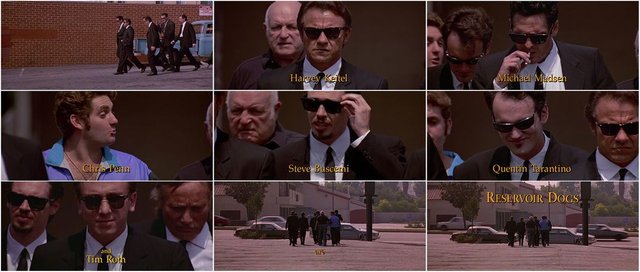🎬 Retro Sunday : RESERVOIR DOGS / Essay
It's extremely difficult to briefly write about Quentin Tarantino with whose name, as well as films, are familiar even those that film theory and history bypassed. Therefore, it is possible that the best option is to start from the movies themselves and to avoid listing a long line of already canonized stylistic features. With his debut thriller, Reservoir Dogs (1992), Tarantino opened the way for further development of a largely recognizable and unmistakable, end even then mature and formed movie style.
Reservoir Dogs was proclaimed a cult classic and the best independent film in the history of cinema. In the context of Tarantino's filmography, it became the bearer and synthesis of elements that in a relatively short time became the trademark of his film style and range from narrative elements to cast.
The central motive of the film is the robbery, though, it's not shown. Specifically, Tarantino views the events that took place before and immediately after the robbery itself, making Reservoir Dogs so-called heist film. The robbery was carried out by a group of five men. Tarantino chose a strong cast, roles of robbers in suits are: Harvey Keitel, Tim Roth, Steve Buscemi, Michael Madsen and Quentin Tarantino himself appears in a small role.
The plot has a non-linear narrative structure framed motive of the crime, and, since there is no chronology, to the viewer the story is presented in fragments, and certain parts of the story are learned exclusively from the dialogue of the characters.
Even though with movie classics, like this one, there is no need to analyze the story, Reservoir Dogs undoubtedly contain scenes that are worth highlighting.
The introductory scene begins with words spoken by Tarantino himself, and after only a few seconds the viewer is given a visual insight. A dynamic camera circles around the round table at which there are six men talking continuously, although the viewer only in the fragments sees who of them at a given time has a word.
The themes of their conversations, ranging from discussing the meaning behind Madonna's songs to those about socially accepted conventions, such as giving tips, open the way with intriguing and interesting dialogues pervaded by sharp humor, vulgarity, and references to popular culture.
The whole scene counts a large number of cuts, short and long shots, close and big plans. Namely, Tarantino is playing with the film form from the very beginning, which significantly enriches the content and atmosphere and opens the way to a unique and fun style.
Tarantino doesn't show us all the characters at the same in the introductory scene. Even in the final frame, one of the characters remains omitted. In this way, Tarantino leaves the characters and their interrelationships and ambitions to be undefined and mysterious. The introductory scene follows the introductory bundle in which the dynamic camera follows the slow motion of the men's group and is also the first moment in which the characters are shown in the crowd.
This legendary scene, which inspired styling of million bachelor parties, Tarantino assures us that we will see a robbery performed to perfection by best laid back types since the Rat Pack made "Ocean's Eleven" in 1960.
After the camera becomes static, the viewer follows the disappearance of a group of men while in the background plays Little Green Bag, the first in a series of songs Tarantino has included in the film under the fiction radio station K-Billy : K-Billy's Super Sounds of the Seventies Weekend.
The central event, that is, the robbery of jewels, remains hidden from the viewer. However, we are aware of the events that followed, because the whole crime was brilliantly derived from the dialogue of characters that, regardless of the amount of information on previous events, remains natural, simple and fun. Also, since men point to each other with nicknames that match color names, it's relatively easy to understand that the perpetrators of crime are not familiar with each other, which can be followed by the conclusion that a plan for a perfect crime has broken apart for a reason.
However, the framework for understanding the plot and the relationship between the characters is not just in the dialogue. Tarantino's characters gather after a robbery in an abandoned warehouse where the most spectacular scene of the movie will take place. After he succeeds in kidnapping a cop, Mr. Blonde (Michael Madsen) decides to take him to the storeroom where they all decided to meet. While the scene of brutal and bloody violence, in which the most bizarre scene remains hidden by the sudden rise of the camera, and intertwining with song Stuck in the Middle with You, the audience witnesses the fun and dance content that turns into the outbreaks of severe violence that, when the viewer becomes aware of, is just too late to unseen.
And now to the fun part!
TRIVIA & FUN FACTS
Tarantino Body Countdown
(click to enlarge)
* The empty building where the second part of the film is shot, was in fact a mortuary.
* Mr. Blue was an actual bank robber in real life. Eddie Bunker spent much of the first half of his life in various correctional facilities. He even wrote semi-autobiographical crime book titled Little Boy Blue, and yes, Tarantino was a fan. * The film was planned to be shot for just $30,000 until Harvey Keitel saw the script and came on as Mr. White & the executive producer, which increased the budget to $1.2 million.
* Madonna send Tarantino a signed record of “Like A Virgin” that said: “To Quentin. It’s not about dick, it’s about love. Madonna”
* Quentin Tarantino says that the briefcase from Pulp Fiction was originally supposed to have contained a cache of diamonds before Tarantino decided that keeping the contents of the briefcase ambiguous made it more interesting. Since Pulp Fiction and Reservoir Dogs take place in the same universe (Vic and Vincent Vega, major characters in both films, are brothers), it's been theorized that the briefcases in both films are actually the same briefcase, which would mean that someone in the criminal underworld sold the diamonds to Brett and his gang before the police could return them to their rightful owners.
* In Mr. White's flashback, Joe asks him about a girl named Alabama. This is a reference to Patricia Arquette's character from True Romance. Quentin Tarantino has stated that he originally intended this character to meet up with Mr. White and to become partners in crime. When "True Romance" was released a year after this film, the ending was changed and so this backstory became inconsistent because Alabama never went on to meet up with Mr. White.
Quentin Tarantino talks about Reservoir Dogs (1992)




This is probably still my favorite Tarantino movie.
Nice initiative - retro Sunday - hope you can keep it up ;>)